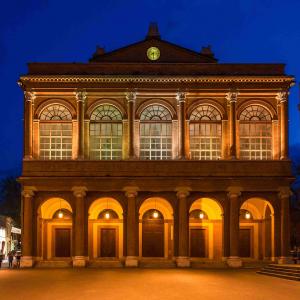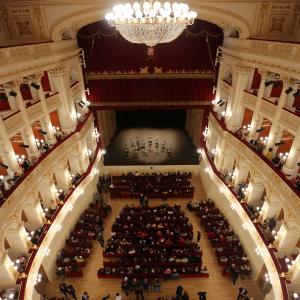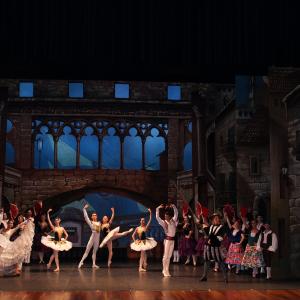Theatre Amintore Galli
History | 1841 Luigi Poletti's project
On 15 May 1841 Luigi Poletti of Modena (1792-1869), an illustrious architect linked to the Roman purist neoclassical school, was commissioned to design the New Theatre in Rimini. Poletti designed an Italian-style theatre, but with some significant variations. The music hall has four orders and 23 boxes each, making it one of the largest theatres in Italy. The first order of boxes is exceptionally double-height and supports a solution of giant Corinthian columns that directly support the balustrade of the gallery. The theatre has no royal box. Enlightenment instances are represented by the wide circular staircases in the foyer, designed according to the safety and comfort requirements of the society of the time. The theatre as a whole is recognised as his masterpiece, on a par with the Basilica of St Paul's in Rome, and one of the most significant examples of the overcoming of the neoclassical style in the first half of the 19th century.
1857 Giuseppe Verdi inaugurates the theatre
In the summer of 1857, the theatre named Teatro Nuovo is inaugurated with a memorable opera season by Giuseppe Verdi (the only one in Italy), who presents a new opera, Aroldo, composed especially for the occasion.
In 1859, the theatre was dedicated to Vittorio Emanuele II.
The theatre between the two world wars
Between the years 1916 - 1923 the building is damaged by an earthquake and is closed. On this occasion, in addition to the necessary restorations, the electrical system is installed, the chandelier is replaced and the mystic gulf is created by reducing the length of the stage. In 1923, after restoration, the theatre reopens with Zandonai's opera Francesca da Rimini. A second curtain depicting Paolo and Francesca in the act of kissing was commissioned for the new opening.
Between 1928 - 1931 architect Gaspare Rastelli completed the Ridotto (later Sala Ressi) and the gallery on the upper floor without following Poletti's design, but using neoclassical stylistic features. In the years 1930-1943 the theatre experienced a flourishing opera season that ended in the spring of 1943. Puccini's Madama Butterfly was the last opera performed.
1843 the bombing
On 28 December 1943, during an air raid, the theatre was hit by bombs that caused the roof of the auditorium to collapse, but did not completely destroy the music room. In the immediate aftermath of the war, the theatre was occupied by the military and then, by the people of Rimini themselves, looted of furnishings, furniture and chandeliers in order to use the materials to rebuild homes destroyed by the war. In 1947, the half-destroyed theatre was dedicated to the musician Amintore Galli (1845-1919), a music critic and composer famous both nationally and worldwide for the success of his worker's anthem with lyrics written by Filippo Turati.
2018 the rebirth
28 October 2018 Cecilia Bartoli inaugurates the Amintore Galli Theatre
Rimini's ‘Amintore Galli’ Theatre - on 28 October 2018 - lifted its curtain once again returned to Rimini and the Rimini community. It was inaugurated by the extraordinary voice of Cecilia Bartoli, mezzo-soprano star of world opera, who presented her Cinderella in semi-staged form, accompanied by the Musiciens du Prince.
Ambition: an always open theatre and multimedia museum
The Galli Theatre not only hosts prestigious shows and concerts, but it is also possible to visit and admire it closely outside the performance activity. After the official opening, guided tours have also been organised and scheduled. In addition, the multimedia museum, located underneath the theatre, offers the opportunity to see archaeological finds discovered during excavations for the reconstruction, enhanced and contextualised by multimedia presentations. At present, the new museum space can only be visited on special occasions.
Piazza Cavour, 22 - tel: (+39) 0541 704292, (+39) 0541 704295 | teatrogalli@comune.rimini.it | www.teatrogalli.it


